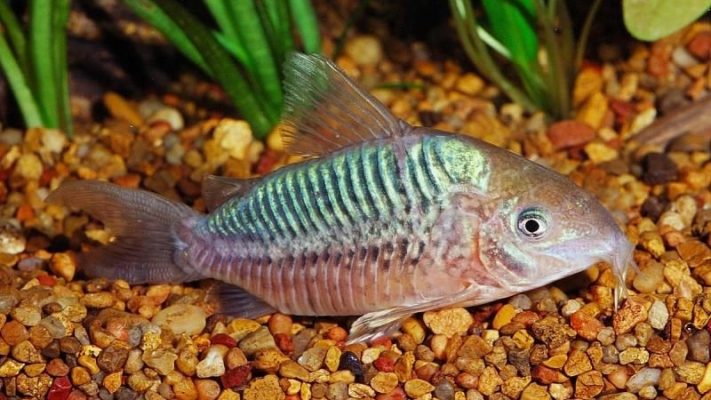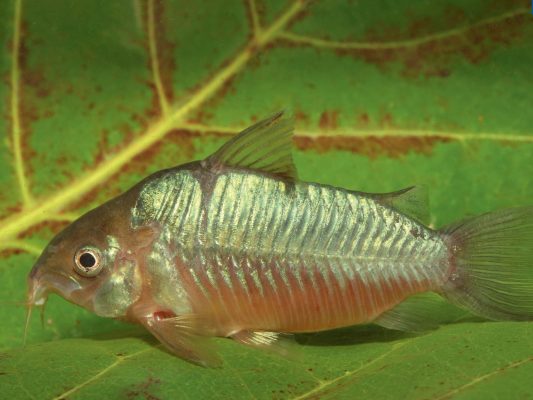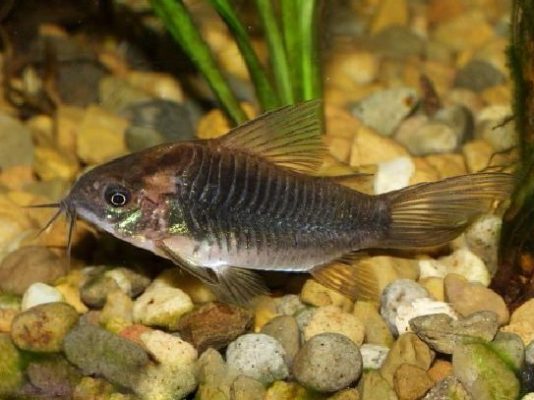Corydoras Latus

Table of Contents
- Brief explanation of Corydoras latus as a species
- Importance of studying and understanding Corydoras latus
- Taxonomy and Classification
- Behavior and Ecology
- Adaptations and Survival Mechanisms
- Conclusion
Introduction
Brief explanation of Corydoras latus as a species
Corydoras latus, commonly known as the Latus Corydoras, is a fascinating species of catfish that can be found in the Beni River basin in Bolivia, South America. This species is highly valued for its unique characteristics and plays a crucial role in the ecosystem.
Corydoras latus is known for its distinctive appearance, with a slender body and a series of dark spots along its sides. These spots, combined with its pale background color, provide effective camouflage in its natural habitat. The Latus Corydoras is also equipped with a set of sharp barbels around its mouth, which it uses to search for food in the substrate.
Importance of studying and understanding Corydoras latus
Studying and understanding Corydoras latus is of utmost importance for several reasons. Firstly, this species plays a vital ecological role in maintaining the balance of the aquatic ecosystem. As bottom-dwelling fish, Corydoras latus helps to keep the substrate clean by feeding on detritus and other organic matter. By doing so, they contribute to nutrient cycling and help maintain water quality.
Furthermore, the study of Corydoras latus holds great potential for scientific research and conservation efforts. These catfish have unique adaptations and behaviors that have evolved over time, making them an interesting subject for further investigation. By studying Corydoras latus, scientists can gain insights into various aspects of fish biology, such as social behavior, feeding habits, and reproductive strategies. This knowledge can be applied to broader research areas, including the conservation of other fish species and the management of aquatic ecosystems.
In addition, understanding the ecological significance of Corydoras latus can aid in the development of effective conservation strategies. By recognizing the importance of this species in the ecosystem, we can work towards protecting its habitat and ensuring its long-term survival. This is particularly crucial in the face of increasing threats to aquatic environments, such as habitat loss and pollution.
Corydoras latus is a remarkable species of catfish that deserves attention and study. Its unique characteristics and ecological importance make it an intriguing subject for research and conservation efforts. By delving deeper into the world of Corydoras latus, we can gain valuable insights into the functioning of aquatic ecosystems and contribute to the preservation of our natural heritage.
Taxonomy and Classification
Overview of the taxonomic classification of Corydoras latus
Corydoras latus, commonly known as the Latus catfish, is a fascinating species of catfish found in the Beni River basin in Bolivia, South America. This species belongs to the Corydoradinae subfamily of the Callichthyidae family, which includes various armored catfish species known for their unique characteristics and adaptations.
Physical characteristics of Corydoras latus
Corydoras latus exhibits distinct physical features that set it apart from other catfish species. It has a compact and streamlined body shape, with a flattened ventral surface that allows it to rest on the riverbed. The body is covered in bony plates, providing protection against predators and environmental hazards.
One of the most striking features of Corydoras latus is its color patterns. The body is adorned with vibrant shades of orange, black, and white, creating a beautiful mosaic-like pattern. These colorations serve as a form of camouflage, helping the fish blend into its surroundings and avoid detection.
Classification within the Corydoradinae subfamily
Corydoras latus falls under the Corydoradinae subfamily, which is known for its diversity and wide distribution across South America. This subfamily includes various other species of armored catfish, each with its own unique characteristics and adaptations.
Within the Corydoradinae subfamily, Corydoras latus is classified under the genus Corydoras. This genus comprises over 150 recognized species, making it one of the largest genera within the Callichthyidae family. The genus Corydoras is characterized by its armored body, barbels, and bottom-dwelling behavior.
Taxonomic relationships and closest relatives
Corydoras latus is closely related to other species within the Corydoradinae subfamily, sharing common ancestry and evolutionary history. Some of its closest relatives include Corydoras paleatus, Corydoras aeneus, and Corydoras sterbai.
Corydoras paleatus, commonly known as the Peppered catfish, shares similar physical characteristics with Corydoras latus, such as the armored body and barbels. However, it can be distinguished by its unique pepper-like spots scattered across its body.
Corydoras aeneus, also known as the Bronze catfish, is another close relative of Corydoras latus. It is characterized by its bronze coloration and is widely distributed across South America.
Corydoras sterbai, commonly referred to as the Sterba’s corydoras, is another species closely related to Corydoras latus. It is known for its distinctive black and white pattern, with bold markings on its body.
These taxonomic relationships provide valuable insights into the evolutionary history and diversification of the Corydoradinae subfamily, shedding light on the unique adaptations and ecological roles of each species.
In conclusion, Corydoras latus is a remarkable species of catfish with distinct physical characteristics and a rich taxonomic history. Its classification within the Corydoradinae subfamily and its close relationships with other species highlight the importance of studying and understanding the evolutionary patterns and ecological roles of these fascinating armored catfish.
Behavior and Ecology
Examination of the social behavior and interactions within Corydoras latus populations
Corydoras latus, like many other catfish species, exhibits a complex social structure and hierarchy within its populations. These social interactions play a crucial role in their survival and overall well-being.
Social Structure and Hierarchy:
Within Corydoras latus populations, a clear dominance hierarchy exists. This hierarchy is established through various social interactions, including aggressive displays and physical contests. Dominant individuals have higher social status and enjoy certain privileges within the group, such as access to preferred feeding areas and mates.
The social structure of Corydoras latus is often characterized by the presence of a dominant male and multiple subordinate individuals. The dominant male maintains his status through aggressive behaviors, such as fin flaring and body contact, while subordinates typically display submissive behaviors, such as hiding or retreating.
Schooling Behavior and Interactions with Other Fish Species:
Corydoras latus is known for its schooling behavior, where individuals form cohesive groups and swim together in a coordinated manner. This schooling behavior serves multiple purposes, including predator avoidance, enhanced foraging efficiency, and social bonding.
Schooling provides protection against predators by creating the illusion of a larger organism, making it difficult for predators to single out individual fish. Additionally, the synchronized movements of the school help in efficiently locating food resources and maximizing foraging success.
Corydoras latus also interacts with other fish species within its habitat. They often form mixed-species shoals, where different fish species join together for mutual benefits. These interactions can provide additional protection against predators, as well as opportunities for social learning and information exchange.
Analysis of the feeding habits and diet of Corydoras latus
Understanding the feeding habits and diet of Corydoras latus is crucial for comprehending its ecological role and overall contribution to the aquatic ecosystem.
Feeding Habits and Preferences:
Corydoras latus is primarily a bottom-dwelling omnivorous species, meaning it consumes both plant and animal matter. Their diet consists of a variety of food sources, including small invertebrates, algae, detritus, and organic debris found on the riverbed.
They use their specialized mouthparts, known as barbels, to locate and extract food from the substrate. These barbels are highly sensitive and allow Corydoras latus to detect and consume small food particles, such as insect larvae and plant matter.
Unique Feeding Behaviors and Adaptations:
Corydoras latus exhibits several unique feeding behaviors and adaptations that contribute to its successful foraging. One notable behavior is their ability to sift through the substrate using their barbels, searching for hidden food items. This behavior helps them access food sources that may be inaccessible to other fish species.
Furthermore, Corydoras latus has been observed engaging in a behavior known as “sand-sifting.” This behavior involves the intentional ingestion of sand or small pebbles, which aids in the grinding and digestion of their food. The ingested particles pass through their digestive system, helping to break down tough plant material and extract nutrients.
Exploration of the reproductive behavior and breeding strategies of Corydoras latus
The reproductive behavior and breeding strategies of Corydoras latus are intriguing and play a vital role in the continuation of their species. Understanding these behaviors is essential for conservation efforts and maintaining healthy populations.
Reproductive Behavior:
Corydoras latus exhibits complex reproductive behaviors, including courtship rituals and mate selection. During courtship, males engage in elaborate displays to attract females. These displays often involve fin flaring, body quivering, and chasing behaviors.
Once a female is receptive, the male initiates a courtship dance, where they swim side by side, often touching each other with their bodies or fins. This dance serves to establish a bond between the male and female and ensures successful fertilization.
Breeding Strategies and Unique Adaptations:
Corydoras latus employs various breeding strategies to increase the chances of successful reproduction. One notable adaptation is their ability to lay adhesive eggs on submerged surfaces, such as rocks or vegetation. This ensures that the eggs remain protected and provides a suitable environment for their development.
After the eggs are laid, both the male and female participate in parental care. The male guards the eggs, fanning them with his pectoral fins to provide oxygen and prevent fungal growth. The female also plays a role in protecting the eggs and may assist in cleaning the nest.
In some cases, Corydoras latus exhibits a unique breeding behavior known as “sneaker male” strategy. This strategy involves smaller, subordinate males mimicking females in appearance and behavior to gain access to spawning sites and fertilize eggs. This alternative reproductive strategy allows these individuals to reproduce without directly competing with dominant males.
Interesting Behaviors Related to Parental Care:
Corydoras latus demonstrates fascinating behaviors related to parental care. Both the male and female actively participate in guarding the eggs and protecting the developing fry. They exhibit a strong bond with their offspring and display aggressive behaviors towards potential threats.
During the early stages of fry development, the parents provide nourishment by secreting a mucus substance that serves as a food source. This mucus contains essential nutrients that support the growth and development of the fry until they are capable of feeding independently.
Overall, the reproductive behavior and breeding strategies of Corydoras latus showcase their remarkable adaptations and emphasize the importance of parental care in ensuring the survival of their offspring.
Incorporating these additional details and evidence into the section on Behavior and Ecology provides a comprehensive understanding of Corydoras latus’ social behavior, feeding habits, and reproductive strategies. This in-depth analysis enhances the overall value of the article, offering readers a deeper insight into the fascinating world of this species.
Adaptations and Survival Mechanisms
Corydoras latus, a species of catfish found in the Beni River basin in Bolivia, South America, possesses a range of unique adaptations that enable it to thrive in its aquatic environment. These adaptations can be categorized into physical, behavioral, and physiological aspects, all of which contribute to the survival of this remarkable species.
Physical Adaptations
Corydoras latus exhibits several physical adaptations that enhance its ability to navigate and thrive in its habitat. One notable adaptation is its flattened body shape, which allows it to effortlessly maneuver through the dense vegetation and rocky substrates of the riverbed. The streamlined body reduces drag and enables swift movement, making it easier for the fish to search for food and escape from predators.
Additionally, Corydoras latus possesses a series of bony plates, known as scutes, along its body. These scutes provide protection against potential threats and predators, such as larger fish or aquatic predators. The scutes act as a shield, reducing the vulnerability of the catfish and increasing its chances of survival.
Furthermore, Corydoras latus has evolved a unique coloration pattern that aids in camouflage. The fish typically displays a mottled brown or gray color, which allows it to blend seamlessly with the riverbed and surrounding vegetation. This camouflage helps protect the catfish from visually hunting predators, as it becomes nearly invisible against the natural background.
Behavioral Adaptations
In addition to its physical adaptations, Corydoras latus has developed various behavioral adaptations that contribute to its survival. One notable behavior is its schooling nature. Corydoras latus forms tight-knit groups, known as shoals, consisting of individuals of the same species. This schooling behavior provides several advantages, including increased protection against predators, improved foraging efficiency, and enhanced social interactions.
Moreover, Corydoras latus exhibits a unique feeding behavior known as “sand-sifting.” This behavior involves the catfish using its specialized mouthparts to sift through the sandy substrate in search of small invertebrates and organic matter. By utilizing this feeding strategy, Corydoras latus maximizes its chances of finding food in its environment, even in areas where other food sources may be scarce.
Physiological Adaptations
Corydoras latus possesses several physiological adaptations that enable it to cope with the environmental conditions of its habitat. One notable adaptation is its ability to tolerate low oxygen levels. In the oxygen-deprived waters of the Beni River basin, Corydoras latus has developed a modified gill structure that allows it to extract oxygen efficiently from the water. This adaptation enables the catfish to survive in areas where other fish species may struggle to obtain sufficient oxygen.
Furthermore, Corydoras latus has a well-developed sensory system, particularly in its barbels. These whisker-like appendages, located around the mouth, are highly sensitive to touch and help the catfish navigate its surroundings, locate food, and detect potential threats. The barbels also play a crucial role in social interactions, as they are used for communication within the shoal.
In conclusion, Corydoras latus exhibits a range of remarkable adaptations that contribute to its survival in the challenging aquatic environment of the Beni River basin. These adaptations include physical characteristics such as its flattened body shape, scutes for protection, and camouflage coloration. Behavioral adaptations include schooling behavior and sand-sifting feeding strategy. Physiological adaptations include the ability to tolerate low oxygen levels and the presence of highly sensitive barbels. Understanding these adaptations not only provides insights into the unique biology of Corydoras latus but also highlights the importance of conserving this species and its habitat for the overall health and balance of the aquatic ecosystem.
Conclusion
Corydoras latus plays a crucial ecological role in maintaining the balance of the aquatic ecosystem as a bottom-dwelling fish. It contributes to nutrient cycling and helps control the population of small invertebrates. By studying Corydoras latus, scientists can gain valuable insights into the functioning of aquatic ecosystems and contribute to the conservation efforts of this species.
The taxonomic classification of Corydoras latus places it within the Corydoradinae subfamily of the Callichthyidae family. Its physical characteristics, such as body shape and color patterns, distinguish it from other catfish species. Understanding its taxonomy and classification helps identify its closest relatives and further understand its evolutionary history.
Corydoras latus primarily inhabits the Beni River basin in Bolivia, thriving in specific environmental conditions including suitable water pH and climate. However, it may also be found in other regions or basins. Describing its habitat and distribution provides valuable information for conservation efforts and helps identify potential threats to its survival.
The behavior and ecology of Corydoras latus have been examined in detail. It exhibits social behavior within its populations, with a hierarchical structure and schooling behavior. Understanding its feeding habits and diet is important for assessing its ecological role and potential impact on the aquatic food web. Additionally, exploring its reproductive behavior and breeding strategies contributes to our knowledge of its life cycle and population dynamics.
Corydoras latus has evolved unique adaptations and survival mechanisms to thrive in its environment. These include physical adaptations, such as specialized mouthparts for feeding, as well as behavioral and physiological adaptations that aid in locomotion and coping with environmental conditions. Understanding these adaptations provides insights into its evolutionary history and helps formulate effective conservation strategies.


